Affiliate links on Android Authority may earn us a commission. Learn more.


Redmi Note 10 Pro review: Low price belies solid specs
Published onMarch 5, 2023

Redmi Note 10 Pro
MSRP:
What we like
What we don't like
Our scores

Redmi Note 10 Pro
The Redmi Note 10 Pro stands atop the new Note 10 family from the Xiaomi sub-brand. With four phones, Redmi is covering a range of price points for various consumers. What you need to know about the Redmi Note 10 Pro is that it features an appealing design, a solid spec sheet, and strong performance in many — but not all — respects.
Find out what’s good and what’s not in the Android Authority Redmi Note 10 Pro review.
Updated June 2021: Updated text throughout with references to Note 10 stablemates and other competitors.
What you need to know about the Redmi Note 10 Pro
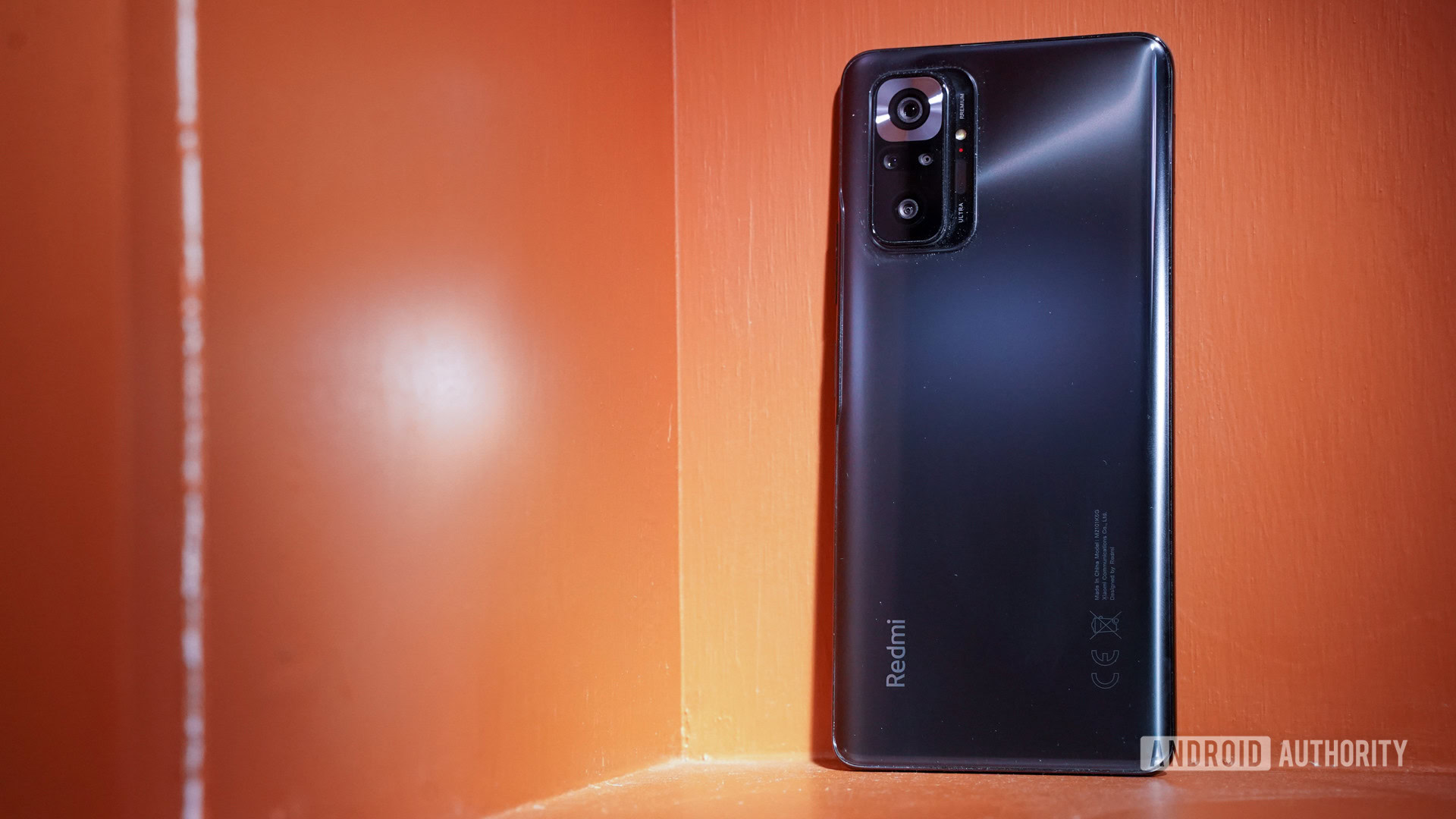
- Redmi Note 10 Pro (6GB, 64GB): £219/$279/Rs. 15,999
- Redmi Note 10 Pro (6GB, 128GB): £249/$299/Rs. 16,999
- Redmi Note 10 Pro (8GB, 128GB): $329/Rs. 18,999
The Redmi Note 10 Pro falls into the upper budget segment and is the successor to the Redmi Note 9 Pro. It’s the most capable of the Note 10 series from Redmi in global markets and offers the most bang for the buck. Onboard you’ll find a solid Snapdragon offering with reasonable RAM and storage options, a high-pixel-count camera, and a large battery. But that’s not all, the Redmi Note 10 Pro packs a lot of smaller, nice-to-have features that really round out the experience.
Things get a little confusing for the India market, however. The Redmi Note 10 Pro in the region features a 64MP main camera as opposed to the 108MP sensor found on the global variant. The latter is instead reserved for the Redmi Note 10 Pro Max, which is for all intents and purposes the Redmi Note 10 Pro everywhere else but with an extra suffix.
Read more: Redmi Note 10 buyer’s guide
The India variant of the Redmi Note 10 Pro also loses the IP54 rating and NFC. The pricing above reflects the regular Note 10 Pro in India and where appropriate we will discuss the pricing of the Indian variant. However, the vast majority of the analysis that follows is reflective of a Redmi Note 10 Pro Max review as far as the hardware is concerned.
Other phones in the family include the Note 10S, Note 10, and Note 10 5G, each with its own, unique set of features. If the Note 10 Pro is still a bit too pricey for you, Redmi has you covered with plenty of options.
But competition is fierce. Dozens of phones are available at the $300 price point. Let’s see if Redmi covered its bases enough to stand out from the crowd.
Design: Good for the money
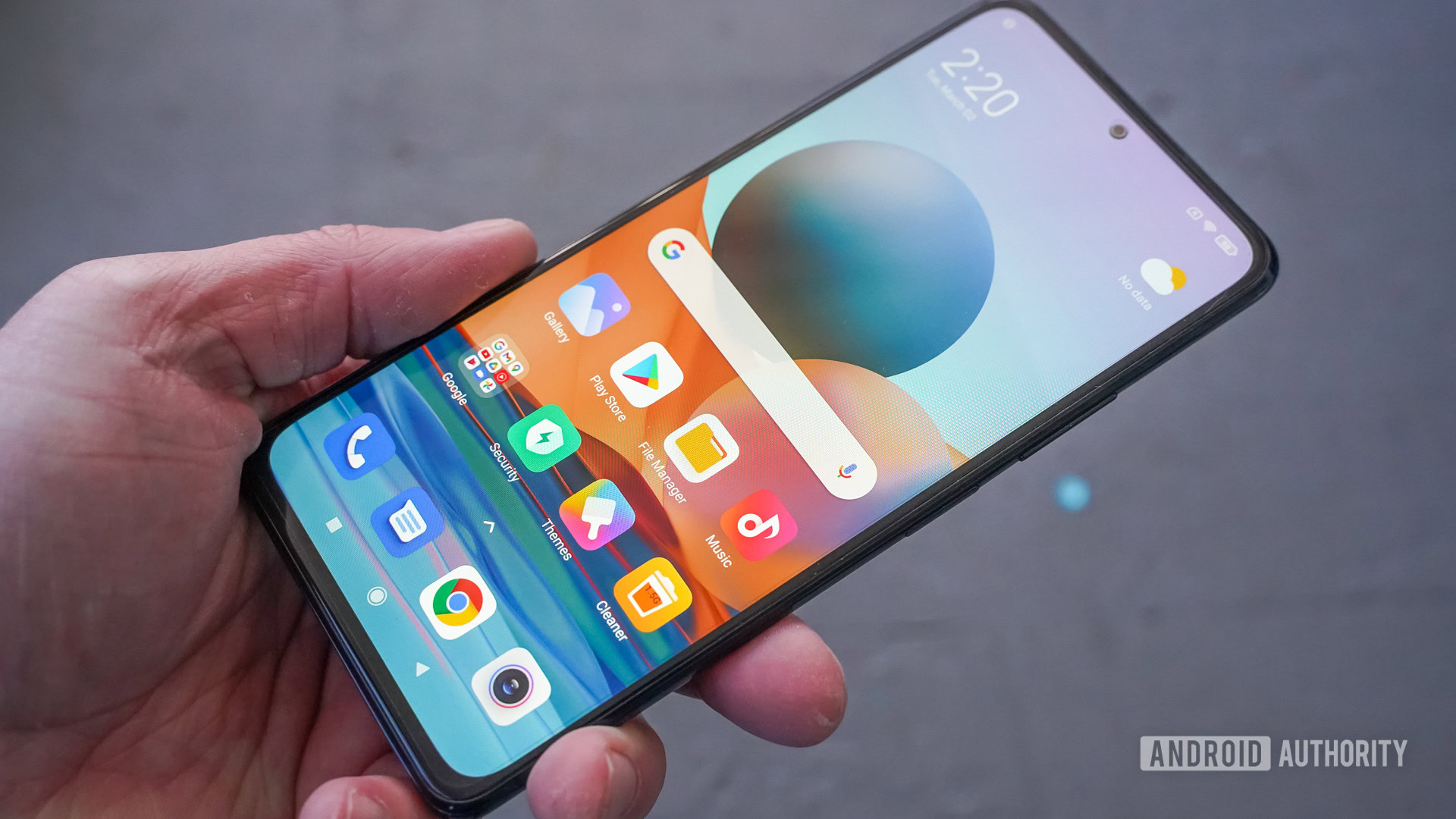
- Corning Gorilla Glass 5
- 164 × 76.5 × 8.1mm
- 193g
- Side-mounted fingerprint reader
- IP53
- Headphone jack
- Stereo speakers
- Onyx Gray, Glacier Blue, Gradient Bronze
The Redmi Note 10 Pro may look like a glass-and-metal slab, but it isn’t. We appreciate the Gorilla Glass 5 that covers the face of the phone and the curved rear glass, but the mid-frame is made of plastics. Redmi did as best it could to give the phone a high-end appearance and it did a mostly convincing job of it.
It’s a svelte device. Redmi kept the thickness in check, which goes a long way. Further, the materials have been polished to a high-gloss sheen that looks more luxurious than it is. The Onyx Gray colorway we have on hand may be steely in its appearance, but fingerprints and grime quickly take away from the experience. I do like that the top and bottom edges of the phone are not only flat but matte. This helps give the phone a small bit of personality.

Usability is about on par with every other super slab these days. The long shape means reaching the top of the display with your thumb is all but impossible. The Note 10 Pro’s high-gloss finish means the phone is crazy slippery. It’ll slide off tables and desks if set at the slightest angle, so take care where you place it. Thankfully this means it slips into and out of your pocket with ease. You can cover it with an included soft case if you wish, which makes it a bit more grippy. It’s a nice weight for a phone this size.
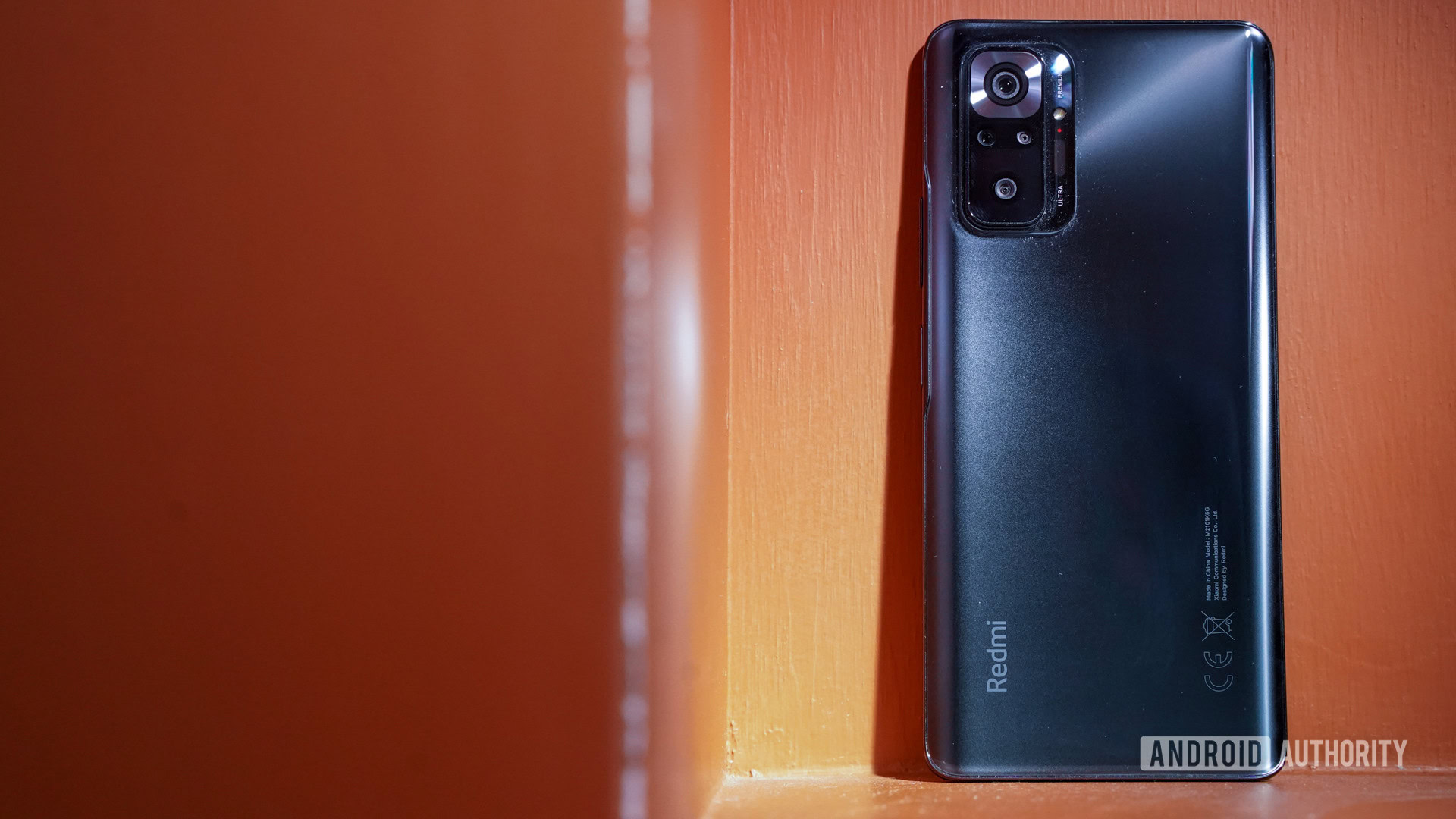
There are a fair number of functional elements scattered around the four edges of the phone. To start, you’ve got the volume toggle and combined power/screen lock button on the right edge. The power button is also the fingerprint reader, which didn’t give me any trouble when it came to training and daily use. These buttons have good action. The left edge houses the combo SIM/memory card tray. The tray can support one microSD card and up to two SIM cards at the same time. With many phones, it’s often an either-or scenario, so that makes the Note 10 Pro more flexible than most.
The Note 10 Pro's high-gloss finish means the phone is crazy slippery.
Elsewhere, a USB-C port is on the bottom, and (believe it or not) a 3.5mm headphone jack is on top. Last, the phone has speakers on the top and bottom which create stereo sound. Volume was very good, but the quality was just a bit thin to my ears.
Redmi overdid it a bit with the camera module, which has two elements stacked one atop the other. It’s a busy design that takes away from the otherwise pure simplicity of the rear cover. In addition to the two-layer arrangement, it has a bright silver element encapsulated in the black framing along with some text. The whole thing is jarring. You can definitely feel the camera module when the phone is in your pocket.
On a whole, the Redmi Note 10 Pro is a mostly cohesive smartphone that potential owners should be happy with.
Display: Doubly fast

- 6.67-inch AMOLED
- Full HD+ (2,400 x 1,080p)
- 394ppi
- 20:9 aspect ratio, 120Hz refresh rate
The Note 10 Pro’s display delivers the right balance of performance and restraint. At nearly 6.7-inches from corner to corner, it’s a sizable screen that doesn’t come across as overlarge. The glass is set into a plastic sub-frame that is then set into the larger mid-frame of the phone. It makes for an extra millimeter of black bezel around the display. Redmi didn’t say what the screen-to-body ratio is, but there’s a small bit of a forehead and chin. You’ll note the centered punch-hole cutout for the selfie camera. It’s small and innocuous.
Many phones shoot for the 20:9 aspect ratio these days, which allows the phone to retain a relatively thin build while also stretching out tall. The Full HD+ resolution works well, and there are plenty of pixels for your eyes to feast upon. I found the 394ppi screen density to be more than adequate for sharp text, icons, and web pages.
The Redmi Note 10 Pro's 120Hz display is very impressive for the price.
The AMOLED panel pumps out plenty of light. It rates 450nits typical brightness, with peaks reaching 1,200nits. The screen also boasts a contrast ratio of 4,500,000:1, which makes for extra inky blacks. YouTube and Netflix look superb.
The Redmi Note 10 Pro offers a fast 120Hz refresh rate. It’s set to 60Hz out of the box, but you can double up the speed for a smoother on-screen experience. It makes a difference. Because the phone is limited to Full HD+ resolution, you can set the Note 10 Pro’s screen to remain at 120Hz all the time. Moreover, the phone’s display supports a 240Hz touch response rate, which makes it better for gaming.
Rounding out the feature list, you’ll find HDR 10 certification, DCI-P3 color gamut, and SGS eye care display certification.
Overall, Redmi has delivered a really good screen for a phone at this price point.
Performance: Not quite the superhighway
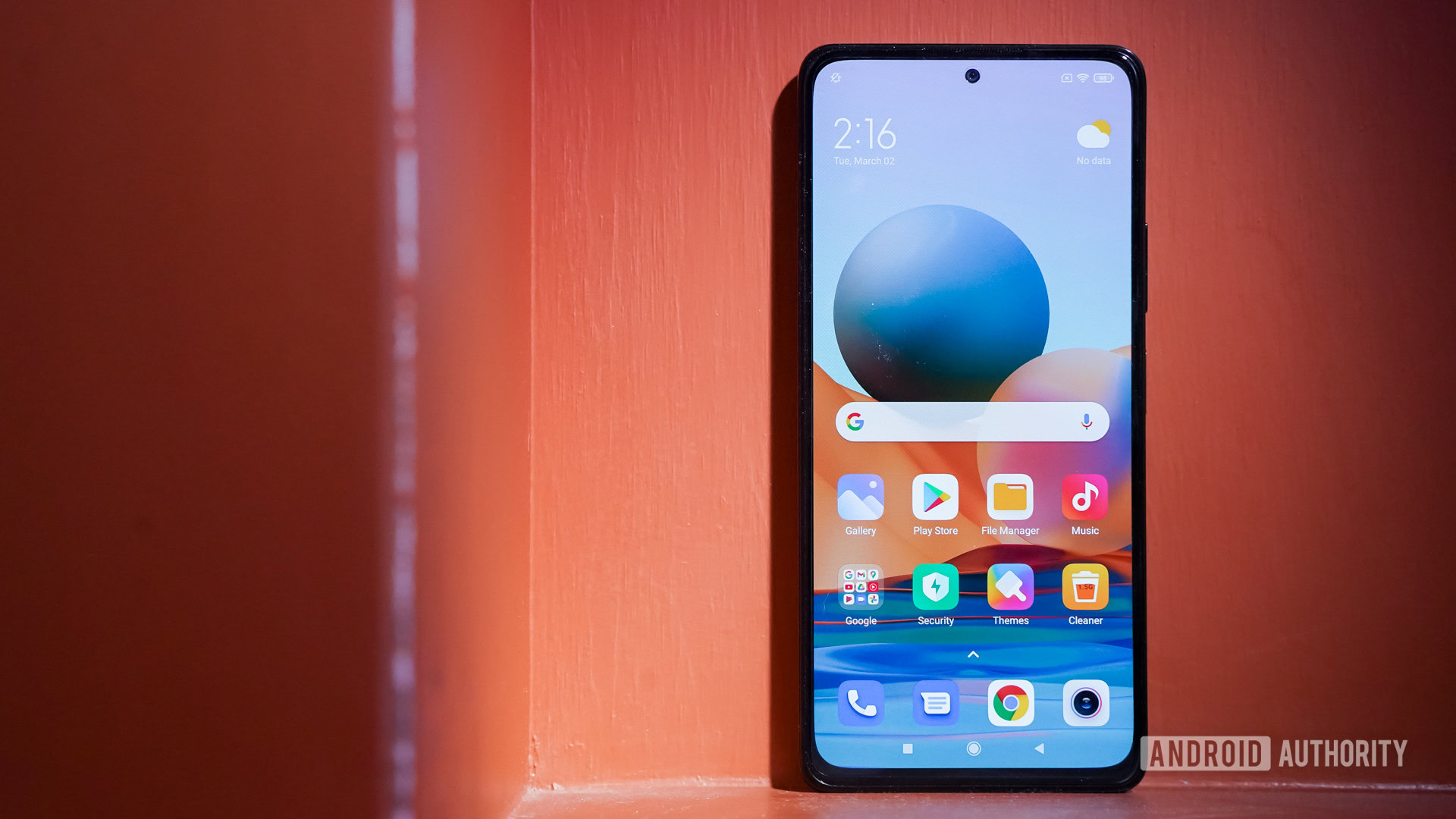
- Qualcomm Snapdragon 732G
- Adreno 618
- 6/8GB LPDDRX4 RAM
- 64/128GB UFS 2.2 storage
The Remi Note 10 Pro doesn’t have the fastest horse in the Snapdragon stable, but it’s not running the slowest either. The Snapdragon 732G is a mid-range processor from Qualcomm that was first introduced to the market in August 2020. It’s an upgrade to the 730G that’s supposed to offer faster clock speeds and better GPU performance for an improved gaming experience. Does it deliver?
In terms of everyday usability, the Note 10 Pro runs at solid speeds. I didn’t encounter any noticeable slow-downs or lagging when using it for catching up on YouTube, browsing the web, or scrolling through social media. I downloaded and played some Asphalt 9 and this is where the phone showed the limitations of the processor. The game was not quite as smooth as I’ve seen it perform on other phones. Game segments took longer to load, and were a little choppier when it came to gameplay. It doesn’t wreck the experience, but you will notice it when playing resource-hungry games.
The phone provides more than enough power for normal use, but it isn't the best choice for gamers.
As far as benchmarks go, the Redmi Note 10 Pro blocked us from using standard, Play Store-available benchmark apps such as Geekbench and 3DMark. We ran our custom Speed Test G benchmark, which runs a timed series of 11 tests to gauge CPU and GPU performance, and the phone came away with a middling score of two minutes 35 seconds. To put that in perspective though, the OnePlus Nord with its superior Snapdragon 765G SoC ran the test in about two minutes 26 seconds, while the Snapdragon 730-toting Google Pixel 4a ran it in two minutes 38 seconds.
In other words, the phone provides more than enough power for normal use, but it isn’t the very best choice for gamers. Nor would we necessarily expect a phone in this price range to be.
Last, the phone is an LTE-only 4G device. There’s no 5G on this device, so don’t expect the world’s best wireless speeds. If 5G is a deal-breaker for you, the Note 10 5G is an option.
Battery: Plenty of reserves
- 5,020mAh battery
- 33W wired charging
- 33W charger in box
If there’s one feature the Redmi Note 10 Pro delivers in spades, it’s battery life. The 5,020mAh power cell is more than a match for the Full HD display and Snapdragon 732G. With the phone at factory settings (Full HD at 60Hz), the phone pushed through one and a half days with ease under heavy duress from testing. I never found myself worried about running out of juice. If I used the phone sparingly, it sometimes lasted through nearly two full days.
Related: Snapdragon SoC guide: All of Qualcomm’s processors explained
If you dial the screen refresh rate up to the maximum 120Hz you’ll take an expected hit to battery life. The faster screen speed slurps up more power and steals about half a day in overall battery life. That means you can get from breakfast to bedtime without issue, but the phone doesn’t last much longer than a full day with moderate-to-heavy use. You can fine-tune it with the various power-saving modes in the battery tool, though you won’t need them if you stick to 60Hz.
The phone supports up to 33W wired charging, which is a respectable speed and an improvement over the Redmi Note 9 Pro’s 18W maximum. It takes about 90 minutes to get the entire battery charged up from dead. Even better, there’s a 33W charger in the box. The phone doesn’t support wireless charging and we wouldn’t expect a phone at this price to carry that feature.
Battery life should suffice for the majority of normal users. Power users who ramp up the screen rate and do a lot of gaming will see shorter battery life.
Camera: Budget buster
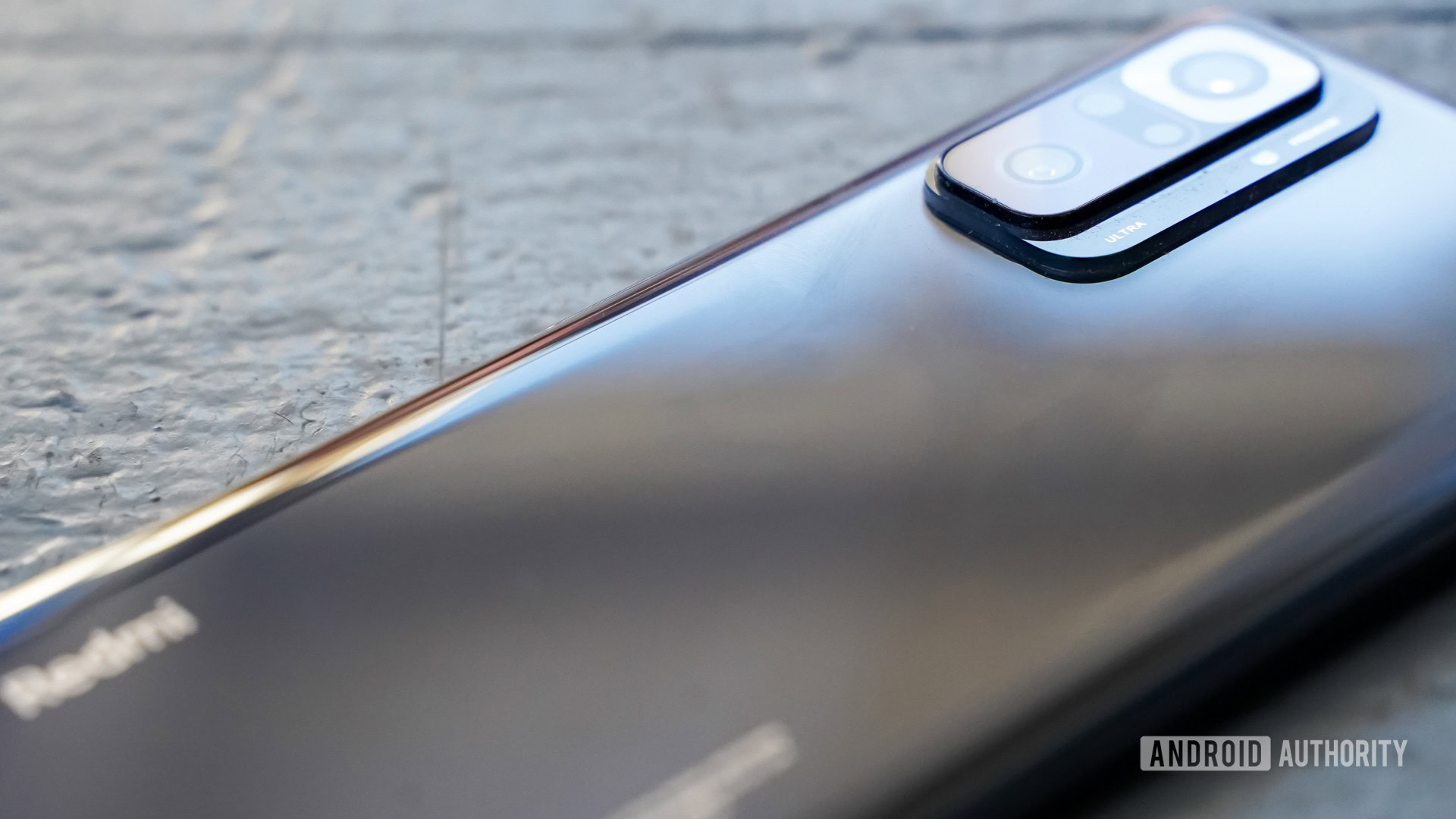
- Main: 108MP (f/1.9, 2.1μm)
- Ultra-wide: 8MP (f/2.2, 118-degree FOV)
- Telemacro: 5MP (f/2.4, AF)
- Depth sensor: 2MP
- Selfie: 16MP (f/2.45)
- Video: 4K at 30fps
Redmi is taking a page from parent Xiaomi when it comes to the camera. The phone skips the preferred standard, wide, telephoto lens arrangement for a standard, wide, telemacro arrangement instead. We saw a telemacro lens on the recent Xiaomi Mi 11. Redmi is relying on the high pixel count of the main camera to handle zooming duties. Is this a user-friendly setup?
Related: The best camera phones you can get
The results should speak for themselves. The main camera is fine for a phone at this price point. Photography basics such as focus and exposure were generally good. If anything, the phone tended to underexpose some frames, which led to loss of detail. Some of those details could be rescued when editing the photos. Case in point, the details of the bridge. I thought the phone handled all the snow fairly well, which showed at least some definition. Colors came across as a bit muted to my eyes, particularly when shooting outdoors.
The Note 10 Pro’s ultra-wide camera is usable, though it has its shortcomings. I noticed a bit more optical distortion from the lens, even with the distortion correction setting toggled on. This means straight lines, such as the horizon, will appear a little bent. The 8MP sensor isn’t the best we’ve encountered and showcased unwanted noise on more than one image. It’s acceptable, but not great. Below is a series of photos taken with the ultra-wide and standard lenses, as well as 2x digital zoom.
The telemacro lens is a mixed bag and its purpose is very situational. It provides an optical boost so you can hold the phone several inches from your subject, rather than directly on top of it. It takes sharp-ish photos, as long as you have a steady hand, but exposure is inconsistent. The problem with macro photography is you often obscure the light you need to get the shot. Telemacro shots were also subject to grain, which can mask details. You might find the 5MP resolution is the limiting factor here. I had trouble getting the best shots, as evidenced below.
Redmi gave the Note 10 Pro a 2MP depth sensor to assist with portraits, and I appreciate that. In general, the phone does a reasonably good job when shooting portraits. Edge detection was on point and didn’t slice anyone’s ears off. Backgrounds were blurred appropriately, though sometimes the subject looked like they were floating on top of, rather than within, a scene.
Selfie lovers should be satisfied with the shots they get from the Note 10 Pro. Standard selfies looked sharp and clean, with good color and little noise. Self-portraits, however, weren’t on par with portraits captured with the rear camera. I saw some soft edge detection from time to time, which made results look less natural.
As for the app, camera modes are plentiful. You get a basic carousel in the viewfinder that slides between pro, video, photo, portrait, and more. Extended shooting modes include night, 108MP, short video, panorama, document scanner, vlog, slow motion, time-lapse, dual video, long exposure, and clone. The video recorder mode has dedicated movie modes, including movie frames, super macro, and motion tracking. Bottom line, the camera app is about as feature-rich and usable as most other camera apps in the market right now.
Lastly, let’s talk video. Redmi limited the phone to 4K at 30fps, which results in sharp video that’s not as smooth as the 60fps footage you might get with slightly pricier phones. Focus was often sharp, exposure was good, and colors were accurate. Video shot in low light tended to be a touch grainy, but that’s not too unusual.
For the price the Redmi Note 10 Pro is a fine shooter. It doesn’t live up to similarly priced fare from Google but it bests rival phones from Motorola, OnePlus, and Nokia.
Software: Bloatware begone
- Android 11
- MIUI 12
Android 11 is at the heart of the Redmi Note 10 Pro — that’s good news. The device ran parent company Xiaomi’s MIUI 12 on top of Android 11. MIUI 12 is improved when compared to previous versions of MIUI. Even better, the phone has been updated to MIUI 12.5, which is supposed to resolve some usability issues. I am not a fan of the fonts and icon treatments, but you may not care about those things.
I’m pleased to report that there’s pretty much no bloatware installed on the global variant of the phone. That came across as a bit of a surprise as this was a major bugbear with its predecessor. Moreover, we didn’t encounter unwanted ads or notifications, which some MIUI phones suffer from.
That’s not the case everywhere, though. A cursory glance at the Indian variant brings up Xiaomi’s long-standing bloatware issue in the subcontinent. Android Authority‘s Dhruv Bhutani encountered this familiar problem when testing the Redmi Note 10 Pro Max. Right off the bat, users are greeted with a pop-up for GetApps, and the phone ships with an assortment of third-party apps like Facebook, Amazon Prime Video, LinkedIn, and more.
Some will surely be pleased that there’s an IR blaster on board and the Mi Remote app so you can control your TV and home audio gear with your phone.
While Redmi has updated the phone to MIUI 12.5, it’s been silent on how long it will support the phone with system-level updates. We’ve contacted Redmi to clarify this and to confirm the long-term update plans for the device. We have yet to hear back.
Redmi Note 10 Pro specs
| Redmi Note 10 Pro | Redmi Note 10S | Redmi Note 10 | Redmi Note 10 5G | |
|---|---|---|---|---|
Display | Redmi Note 10 Pro 6.67 inches Super AMOLED FHD+ 120Hz | Redmi Note 10S 6.43 inches Super AMOLED FHD+ 60Hz | Redmi Note 10 6.43 inches Super AMOLED FHD+ 60Hz | Redmi Note 10 5G 6.5-inch LCD FHD+ 90Hz |
Chipset | Redmi Note 10 Pro Qualcomm Snapdragon 732G | Redmi Note 10S MediaTek Helio G95 | Redmi Note 10 Qualcomm Snapdragon 678 | Redmi Note 10 5G MediaTek Dimensity 700 |
GPU | Redmi Note 10 Pro Adreno 618 | Redmi Note 10S Mali-G76 3EEMC4 | Redmi Note 10 Adreno 612 | Redmi Note 10 5G Mali-G57 MC2 |
RAM | Redmi Note 10 Pro 6/8GB | Redmi Note 10S 6/8GB | Redmi Note 10 4/6GB | Redmi Note 10 5G 4/6GB |
Storage | Redmi Note 10 Pro 64/128GB | Redmi Note 10S 64/128GB | Redmi Note 10 64/128GB | Redmi Note 10 5G 64/128GB |
Battery | Redmi Note 10 Pro 5,020mAh USB-C 33W charging | Redmi Note 10S 5,000mAh USB-C 33W charging | Redmi Note 10 5,000mAh USB-C 33W charging | Redmi Note 10 5G 5,000mAh USB-C 18W charging |
Cameras | Redmi Note 10 Pro Rear: 108MP standard 8MP Ultra-wide 2MP macro 2MP depth sensor Front: 16MP | Redmi Note 10S Rear: 64MP standard 8MP Ultra-wide 2MP macro 2MP depth sensor Front: 13MP | Redmi Note 10 Rear: 48MP standard 8MP Ultra-wide 2MP macro 2MP depth sensor Front: 13MP | Redmi Note 10 5G Rear: 48MP standard 2MP macro 2MP depth sensor Front: 8MP |
Headphone jack | Redmi Note 10 Pro Yes | Redmi Note 10S Yes | Redmi Note 10 Yes | Redmi Note 10 5G Yes |
Software | Redmi Note 10 Pro MIUI Android 11 | Redmi Note 10S MIUI Android 11 | Redmi Note 10 MIUI Android 11 | Redmi Note 10 5G MIUI Android 11 |
Colors | Redmi Note 10 Pro Onyx Gray Glacier Blue Gradient Bronze | Redmi Note 10S Onyx Gray Pebble White Ocean Blue | Redmi Note 10 Onyx Gray Pebble White Lake Green | Redmi Note 10 5G Chrome Silver Graphite Gray Nighttime Blue Aurora Green |
Dimensions and weight | Redmi Note 10 Pro 164 x76.5 x 8.1mm 193g | Redmi Note 10S 160.46 x 74.5 x 8.29mm 178.8g | Redmi Note 10 160.46 x 74.5 x 8.29mm 178.8g | Redmi Note 10 5G 161.81 x 75.34 x 8.92mm 190g |
Value and competition
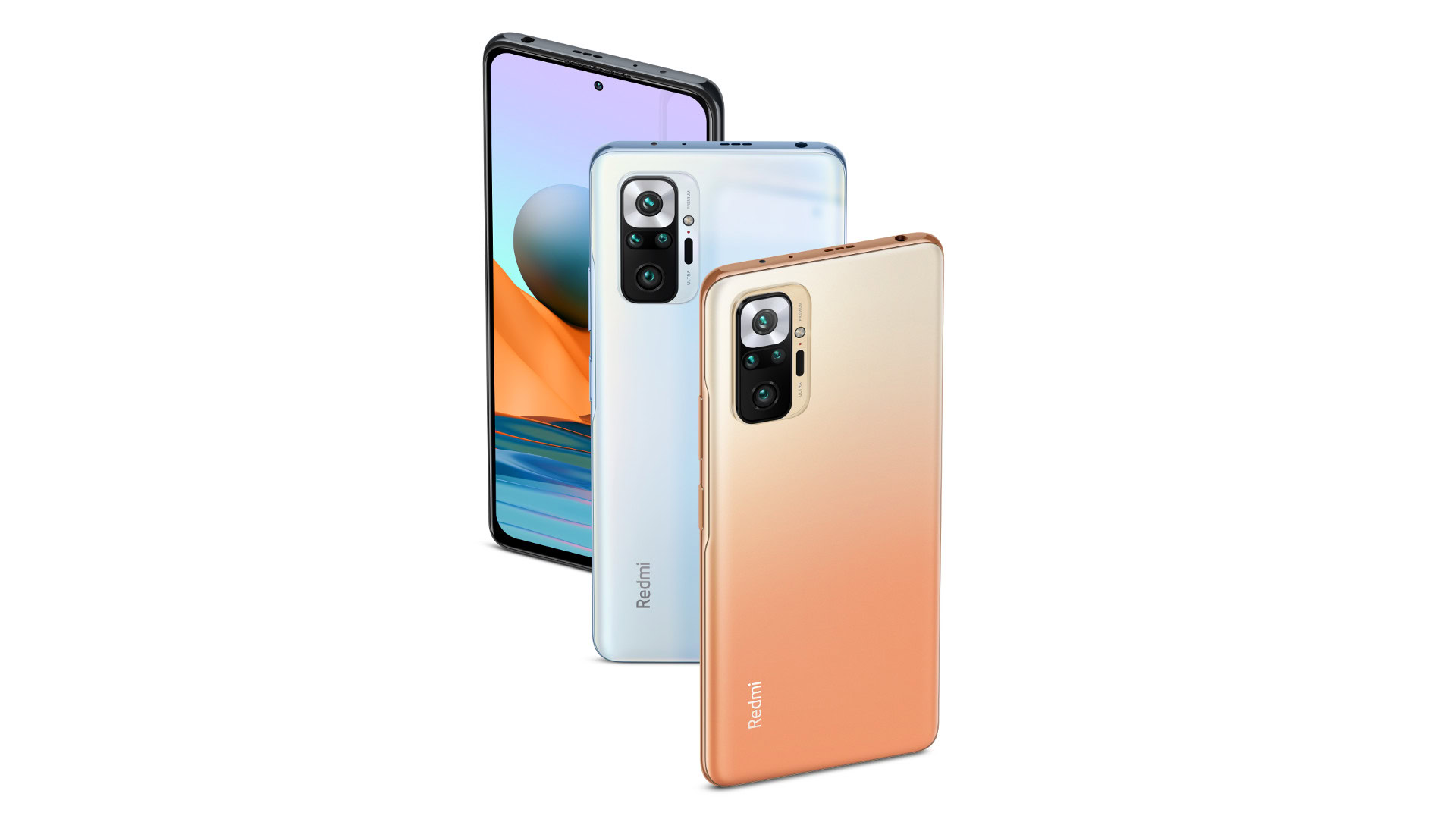
With a price tag of £249/$299/Rs. 16,999 for the middle 6GB/128GB model, the Redmi Note 10 Pro falls into a very competitive landscape, particularly in India where pricing is fierce. Though the 64GB is cheaper, we don’t recommend it due to the limitations of 64GB of storage. You’ll be much happier with the 128GB model. Whether or not you want to spring for the 8GB model is up to you. We tested the 6GB model, so it’s possible the 8G model might perform slightly better on benchmarks. There’s no denying that the phone is priced right, however.
The Redmi Note 10 Pro swings hard at the competition.
Other phones that play in the same ballpark include the realme 8 Pro, which has a 6.4-inch screen, Snapdragon 720G, and 4,500mAh battery. Then there’s the POCO X3, which is a bit less than the others and features a 6.67-inch, 120Hz display, Snapdragon 732G, and 5,160mAh battery. You might also consider the Samsung Galaxy A42, which includes a 6.6-inch screen, a more powerful Snapdragon 750 processor, and a 5,000mAh battery. There’s also the OnePlus Nord CE, which isn’t quite as impressive on the camera front, but does have an upgraded SoC.
Related: The best phones under £300 in the UK | The best phones under 20,000 rupees
For those willing to spend a little extra, the Google Pixel 4a, POCO F3, and OnePlus Nord 2 represent significant upgrades in the camera and performance stakes, respectively. No matter how you cut it, the Redmi Note 10 Pro swings hard at the competition.
In India, things get a little more tricky due to the camera downgrade to 64MP. Many of the phones listed above are still viable alternatives. If you want the 108MP camera you’ll need to instead grab the Redmi Note 10 Pro Max which starts at Rs. 18,999 (~$261). Those that do want the high megapixel camera may want to consider the Mi 10i from parent company Xiaomi. The 6GB/128GB model costs a little more at Rs. 20,999 (~$288), but it does enjoy some upgrades. For example, the 10i has similar specs but adds 5G. The Mi 10i also has a slightly better Snapdragon 750 processor. However, it does lose the AMOLED panel in favor of LCD. The POCO X3 Pro is also available which offers more raw power for a little more cash.
Redmi Note 10 Pro review: The verdict
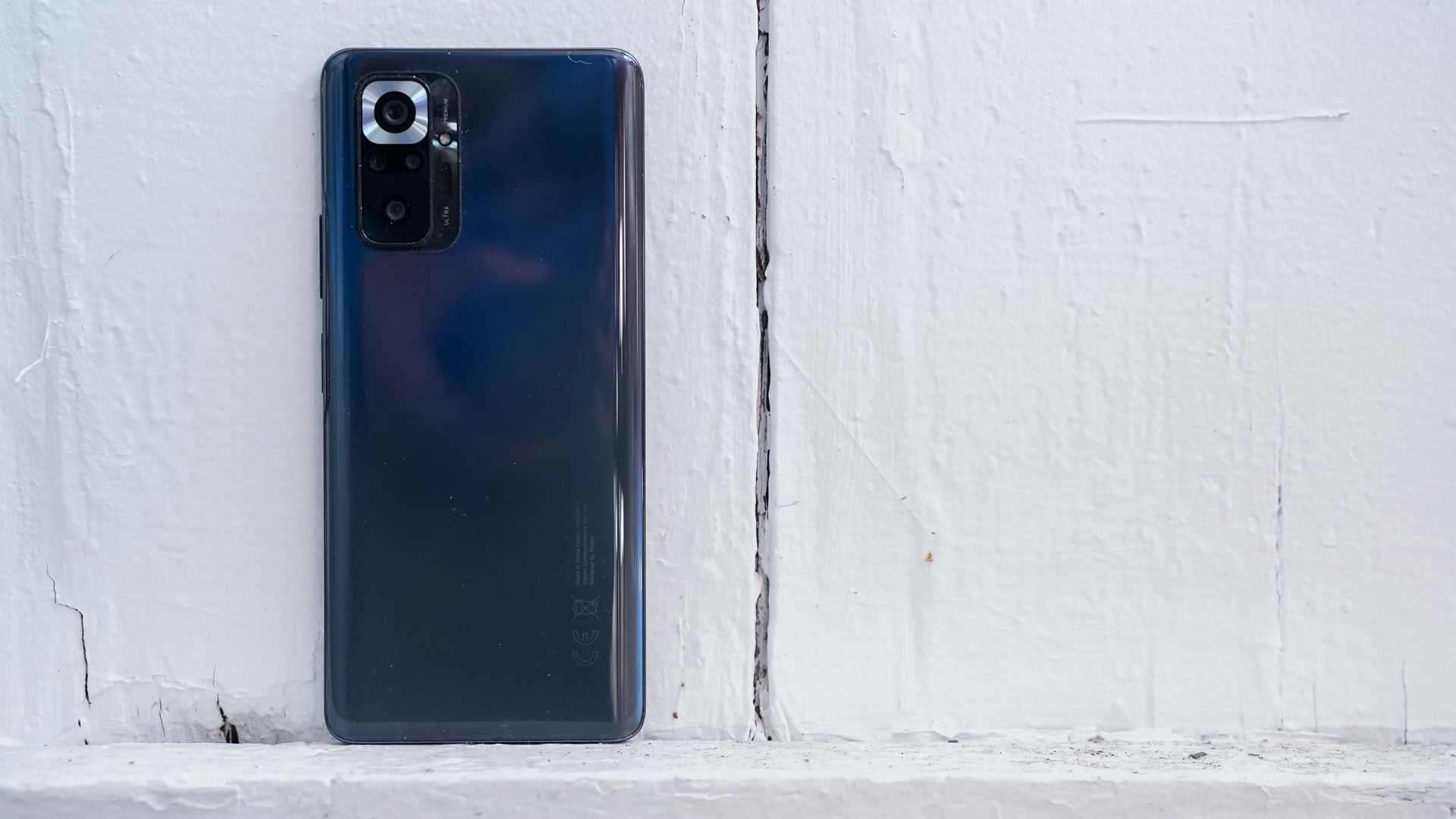
Redmi has a solid offering in the Note 10 Pro. It covers the basics and then some. As the popular choice of the Note 10 family, it stands out thanks to its well-rounded design, surprisingly strong spec sheet, and impressive bang for your buck.
Pros for this phone include user-friendly design elements, such as stereo speakers, support for dual-SIM cards and a memory card at the same time, as well as a headphone jack and Gorilla Glass 5. The Redmi Note 10 Pro also scores well when it comes to display quality and responsiveness. Likewise, battery life is good and the 33W charging is a step up over the Redmi Note 9 Pro.
The Redmi Note 10 Pro scores well thanks to its user-friendly design, responsive display, and solid battery performance.
Cons for the Note 10 Pro include the MIUI 12.5 user interface skin. The camera is plenty versatile and overall adequate, but it can’t match the Pixel 4a. And while it manages everyday usability with ease, the mid-range processor doesn’t deliver scorching performance.
Overall, the Redmi Note 10 Pro is a strong offering and a compelling choice for an upper-budget smartphone.